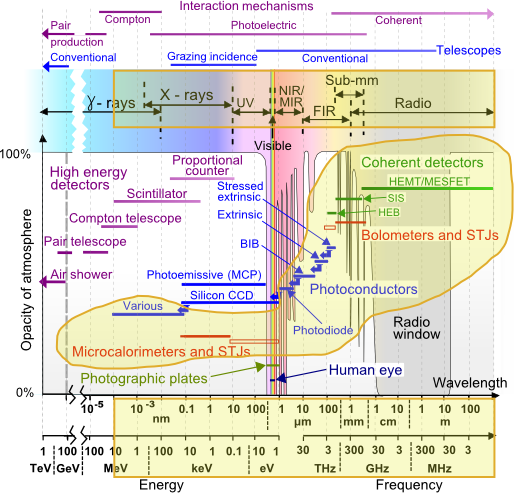
CIRL home
Background
Facilities
Tools
Publications
People
Background home
Cryogenics
Astronomy
Cryogenic detectors in astronomy

The figure above shows the different types of detector used in
astronomy across the electromagnetic spectrum. Detector types that
are usually or always operated cryogenically are highlighted in yellow,
as are the energy/wavelength ranges and types of radiation for which
cryogenic instruments are used. CCDs and scintillators are operated at
temperatures of 150 K and above; we have not considered this to be a cryogenic
temperature range here, though it is common to cool CCDs using
liquid nitrogen (which has a boiling point of 77 K).
Further information is given below.
Radio astronomy
Depending on the wavelength, the first stage in detecting a signal in
radio astronomy is either a low noise amplifier such as a HEMT (high
electron mobility transistor) or heterodyne mixer. In both cases,
cryogenic operation reduces noise, and some mixers, such as SIS
(superconductor-insulator-superconductor) and HEB (hot electron
bolometer) mixers rely on superconductivity and therefore must operate
at cryogenic temperatures. In general, operating temperatures vary
upwards from 4 K, used for some heterodyne systems operating at wavelengths
of around 1 mm.
Sub-mm astronomy
At sub-mm wavelengths (loosely defined as from around 200 μm to a few
mm), radio astronomy techniques are used for high spectral resolution
measurements.
For continuum measurements and low spectral resolution, bolometers are
generally employed. These are operated at ultra-low temperatures
(300 mK or lower). The main reason is to reduce the heat capacity
sufficiently to obtain low enough time constants for the detectors
to be useful. Alternative technologies such as STJs (superconducting
tunnel junctions) and KIDS (kinetic inductance detectors) rely
on superconductivity and thus must also operate at cryogenic temperaturs.
Cryogenic operation would in any case be required at these wavelengths
in order to reduce the black-body radiation from the instrument itself,
but this would not require such extremely low temperatures. Ideally
the telescope itself would also be cooled below room temperature for
the same reason; this is possible in space, but not practical on the ground
as the entire telescope would have to be inside a vacuum chamber in order
to prevent condensation of water and even atmospheric gases on the
telescope surface.
Infra-red astronomy
Infrared astronomy covers the wavelength range from around 1 μm to
a few hundred μms. As with sub-mm astronomy, cooling of instruments
is required to reduce black-body radiation, and in space the telescope
itself is also cooled. Photoconductors dominate for detection, and
cooling is required to reduce dark noise (electrons promoted into the
conduction band by thermal excitation rather than the detection of a
photon). The bandgap required depends on the wavelength of photons to
be detected; at longer wavelengths, and thus lower photon energies, a
small bandgap is required. The dark current depends on temperature and
the bandgap size, with smaller bandgaps requiring lower temperatures to
effectively supress dark current. Temperatures of a few K are
required at 200 μm, while operation at temperatures as high as 100 K
is possible at a few μm.
Optical astronomy
CCD (charge coupled device) cameras are used almost exclusively for
optical astronomy, having replaced photographic film and other types of
detector that have been used historically. While they have many advantages
over photographic film, such as excellent linearity and vastly greater
sensitivity, they do require cooling for the best sensitivity. As with
infra-red detectors, the reason is to reduce thermal excitation of electrons
(dark noise). However, since the bandgap is greater than for
infra-red detectors, the cooling requirements are more modest, and
operating temperatures of 150 K to 200 K are common;
this is not generally considered to by a cryogenic temperature range.
At optical and shorter
wavelengths, there is no need to cool in order to reduce blackbody radiation.
Ultra-violet astronomy
CCDs can be used in the ultra-violet as well as optical wavelengths,
operating at similar temperatures. Photoemissive devices such as
photomultiplier tubes and microchannel arrays are also used; these
operate at room temperature.
X and gamma ray astronomy
CCDs are also used to detect X-rays, but there are many other types of
detector used for X and gamma ray astronomy.
Operating temperatures are equally variable, covering
the range from room temperature (for detectors such as scintillators)
to below 100 mK for microcalorimeters (bolometers which detect the heat
pulse due to the absorption of a single photon).
Due to the near total extinction by the atmosphere at these
wavelengths, observations must be carried out from space.
Return to background main page.
Page created: Adam Woodcraft
Last edited 2008-4-15
Site map













